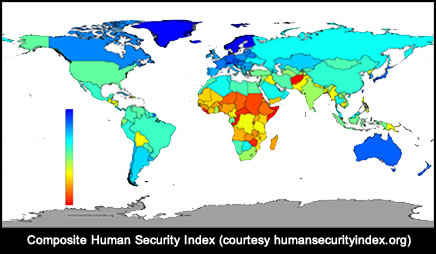HS Index and International Comparisons
With the development of the concept of human security, the need to construct a methodological instrument to allow comparison of the status of human security at an international level developed at the same time. The result of these endeavours was the establishment of the Human Security Index – HSI, the first version of which was created in 2008, and its enhanced version (HSI 2) (Hastings, 2010) released at the end of 2010.
The Human Security Index consists of three key components, which include various different indicators[1]:
1. Economic Fabric Index:
a. GDP per capita at purchasing power parity
b. Equality of income distribution (measured using Gini Coefficient)
c. Financial-Economic Governance (risk of hardship through unsustainable trade or debt, or from catastrophic health care governance disaster)
2. Environmental Fabric Index:
a. Environmental Vulnerability
b. Environmental protection (clean water, etc.), policies & deliveries
c. Environmental sustainability
3. Social Fabric Index:
a. Health (life expectancy at birth, % of population using improved water source, Health outcome equality)
b. Education and info empowerment (Literacy rate, Connection Index, Press Freedom Index)
c. Protection of, and benefits from, diversity (Gender Gap Index, indices on race, ethnicity, religion, age, “disability” issues)
d. Peacefulness (Global Peace Index, World Prison Population List, Political Terror Scale)
e. Governance, including protection from official or illegal corrupt practices
f. Food security (% of people below local poverty index, food imports compared to exports and GDP, % of population food insecure, % of people undernourished, % of productive land per capita) (Hastings, 2011).
232 countries have so far been included in human security research using the HS index. This type of research is very helpful when making comparisons at the global level (although data on each of the monitored indicators are not available in all countries). As opposed to usual quantitative research, which observes isolated parameters (e.g. only GDP per capita), HSI actually represents a composite index taking into account a large number of parameters, and based on these, ranks countries according to the current level of human security (the fact that a country has a greater GDP per capita does not necessarily mean that the level of economic security will be higher in this country if a high level of inequality in income distribution is recorded).

As in case of any other research method, HSI has its own advantages and disadvantages. According to Kanti Bajpai, an HSI could have at least five uses (Bajpai, 2000):
- Developing a social early warning system,
- Focusing attention on problem areas,
- Redefining national and international policy priorities[2],
- Setting national and international standards,
- Generating new social scientific knowledge.
On the other side, there are certain challenges related to use of HSI as a measure of human security. For example, there is a dual problem of validity and reliability – different components of HSI must be valid representations of what they are each intended to represent, but also the various measures should be reliable, i.e. “they should be constructed in the same manner cross-nationally and cross-temporally so that the measure of human security is “stable” and therefore comparable across space and time” (Bajpai, 2000). Also, HSI is still an “objective” measure of human security and it needs to be supplemented with some other methods (for example with public opinion survey), in order to adequately interpret social reality (Ibid).
[1] http://www.humansecurityindex.org/
[2] About relationship between HS as a theoretical concept and as a policy tool see in Owen, T. (2004) Human Security – Conflict, Critique and Consensus: Colloqium Remarks and a Proposal for a Threshold-Based Definition, Security Dialogue, Vol. 35, No. 3, pp. 373-387.
